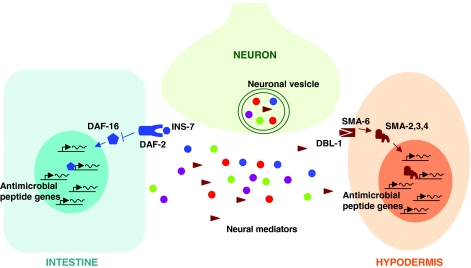Fig. 1.
Nervous system regulation of epithelial and epidermal innate immunity in C. elegans. Simplified depiction of our current understanding of mechanisms by which the nervous system interacts with and instructs the innate immune system in C. elegans. Neural mediators, which include identified neuropeptides (INS-7 and DBL-1), the neurotransmitter dopamine and as-yet-unidentified neuropeptides and neurotransmitters, are secreted from specialized membrane-bound vesicles in neurons and function in a non-cell-autonomous manner to regulate the expression of immune genes in epithelial and epidermal cells through known or unknown immune signaling pathways in C. elegans. Neuronally expressed INS-7 peptide released from dense-core vesicles activates DAF-2 (insulin/IGF-1 receptor) and suppresses expression of DAF-16-regulated antimicrobial genes (Kawli and Tan, 2008). Neuron-derived DBL-1 binds TGFβ receptor SMA-6 and activates the SMAD complex (SMA-2, -3 and -4), which regulates the expression of target genes involved in the immune response (Zugasti and Ewbank, 2009). This schematic is simplified and underestimates the regulatory complexity in space and time, because all interactions are depicted as occurring simultaneously in a single cell of a given cell type. INS-7, neuropeptide ligand for IIR-FOXO; DAF-2, IIR receptor; DAF-16, FOXO transcription factor; DBL-1, TGFβ ligand; SMA-6, TGFβ receptor; SMA-2,3,4, SMAD complex.

